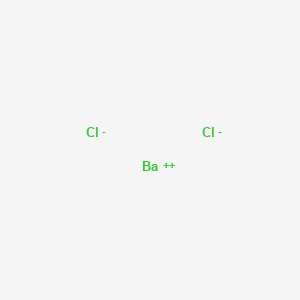
Barium(2+) dichloride
描述
See also: Barium chloride (preferred).
科学研究应用
Analytical Chemistry
Gravimetric Determination of Sulfates
Barium dichloride is primarily used in analytical chemistry for the gravimetric determination of sulfate ions. In this process, a solution containing sulfate ions is treated with barium dichloride, resulting in the formation of barium sulfate, which precipitates out of solution. This reaction can be represented as follows:
The precipitate is then filtered, dried, and weighed to determine the sulfate content in the original sample. This method is widely employed due to its accuracy and reliability in quantifying sulfate concentrations in various samples, such as water and soil .
Industrial Applications
Purification of Brine Solutions
In industrial settings, barium dichloride is utilized for the purification of brine solutions in caustic chlorine plants. It helps remove impurities that can affect the quality of chlorine produced . Additionally, it plays a role in the manufacturing of heat treatment salts used in metal processing.
Production of Pigments
Barium dichloride serves as a precursor for producing various pigments, including Lithol red and Red Lake C. These pigments are used in paints and coatings due to their vibrant colors and stability .
Oil and Gas Industry
In the oil and gas sector, barium compounds are essential for creating drilling muds. Barium sulfate, derived from barium dichloride, is commonly used to enhance the density of drilling fluids, aiding in the lubrication and cooling of drill bits during operations .
Environmental Applications
Water Treatment
Barium dichloride is employed in water treatment processes to remove sulfate ions from wastewater. Its ability to precipitate barium sulfate makes it effective in reducing sulfate levels to meet environmental regulations .
Case Study 1: Barium Chloride Toxicity Management
A recent case study highlighted the toxic effects of barium dichloride when ingested. The study documented a fatal case of barium chloride poisoning, emphasizing the importance of handling this compound with care due to its high toxicity levels. The report noted that while barium sulfate is safe for ingestion, other forms such as barium chloride are bioavailable and pose significant health risks .
Case Study 2: Industrial Use in Drilling Fluids
Another study focused on the application of barium sulfate derived from barium dichloride in drilling fluids for oil extraction. The research demonstrated that using barium-based drilling muds improved drilling efficiency and reduced equipment wear by providing better lubrication compared to traditional fluids .
Summary Table of Applications
| Application Area | Specific Use | Chemical Reaction/Process |
|---|---|---|
| Analytical Chemistry | Gravimetric determination of sulfates | |
| Industrial Production | Purification of brine solutions | Removal of impurities |
| Production of pigments | Synthesis of Lithol red | |
| Oil & Gas Industry | Drilling muds | Enhances density and lubricates drill bits |
| Environmental Science | Water treatment | Precipitation of barium sulfate |
属性
分子式 |
BaCl2 |
|---|---|
分子量 |
208.23 g/mol |
IUPAC 名称 |
barium(2+);dichloride |
InChI |
InChI=1S/Ba.2ClH/h;2*1H/q+2;;/p-2 |
InChI 键 |
WDIHJSXYQDMJHN-UHFFFAOYSA-L |
SMILES |
[Cl-].[Cl-].[Ba+2] |
规范 SMILES |
[Cl-].[Cl-].[Ba+2] |
产品来源 |
United States |
Synthesis routes and methods I
Procedure details








Synthesis routes and methods II
Procedure details








体外研究产品的免责声明和信息
请注意,BenchChem 上展示的所有文章和产品信息仅供信息参考。 BenchChem 上可购买的产品专为体外研究设计,这些研究在生物体外进行。体外研究,源自拉丁语 "in glass",涉及在受控实验室环境中使用细胞或组织进行的实验。重要的是要注意,这些产品没有被归类为药物或药品,他们没有得到 FDA 的批准,用于预防、治疗或治愈任何医疗状况、疾病或疾病。我们必须强调,将这些产品以任何形式引入人类或动物的身体都是法律严格禁止的。遵守这些指南对确保研究和实验的法律和道德标准的符合性至关重要。













